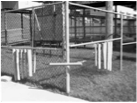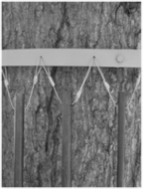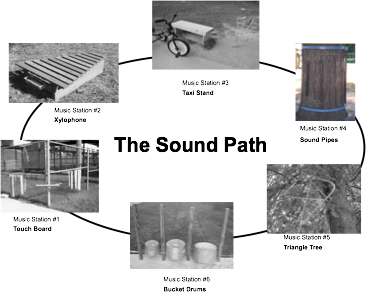Sound Path
Sound Path
A Multi-Stimulation Outdoor Path for
a Child With Visual Impairments
Overview
Designed by
Dr. Petra Kern and colleagues at the FPG Child Development Institute at the University of North Carolina at Chapel Hill, USA
Site
Playground of the FPG Child Care Program.
Purpose
To facilitate social interaction, meaningful play, and orientation & mobility of a child with visual impairment.
Equipment
Touch Board, Guiro Pipe, Xylophone, Taxi Stand, Sound Pipes, Triangle Tree, Bucket Drums.
Safety
Design and construction meet the U.S. Playground Safety Regulations.
Intervention Strategy
Embedded Music Therapy Interventions; Collaborative Consultation, and Staff Training.
Materials
Songs and music therapy intervention.
Research
Inclusion of a children with visual impairment using the Sound Path and an embedded music therapy intervention.
Publications
Journal of Music Therapy (JMT)
Young Exceptional Children (YEC)
Music Therapy Today (MTT)
Replication of Concept
Music Adventure Playground Project (MAPP), Monroe County Intermediate School District, Michigan (Contact: Angela Snell, MT-BC).
Sound Garden, Alternatives for Children, Long Island, NY (Contact: Elisabeth Schwartz, LCAT, MT-BC).
...and many more.

Idea
The Sound Path is an auditory, visual and tactile stimulation path, including six musical stations equipped with various self-made instruments at meaningful locations on the playground. It was originally designed for a three-year-old boy with congenital blindness, who was enrolled at the Frank Porter Graham (FPG) Child Care Program at the University of North Carolina at Chapel Hill, USA.
Concept
The concept of the Sound Path involves two major ideas: 1) a permanent “path” to define the playground space and to facilitate purposeful movements of the child with visual impairment, and 2) the music stations situated in predictable positions on the playground to identify significant play areas and play opportunities for both the child with visual impairment and his peers. The Sound Path was designed by Dr. Petra Kern and implemented with colleagues and parents.
Path
Created from a drainage pipe, partially submerged in the ground, the path encircles the playground. As with a guiro, a Latin American percussion instrument, the pipe (Guiro Pipe) has rides and produces sounds when rubbed with a stick. The Guiro Pipe connects the short distances from one music station to another and is interrupted near each station. A wooden cart with a rubber flap attached to the bottom is used to cruise along the path. Auditory feedback is given when the cart is pushed off the pipe or interrupted by a music station.
Music Stations
The six music stations include the Touch Board, a Guiro Pipe, a Xylophone, a Taxi Stand, the Sound Pipes, the Triangle Tree, and Bucket Drums (see photographs). The music stations are designed to provide sensory experiences by using materials with different textures and and contours, shapes, sizes, colors, and sounds and functions to attract children and promote exploration and interaction.
Songs and Finger Game
To enhance the peer interactions of the child with visual impairment, Dr. Kern composed six play songs and a finger game for each musical station (see Songbook). Each of the pieces requires children’s attention and peer interaction, or asks children to perform specific actions. The simplicity of the songs makes it easy for children and adults to learn and apply them on the playground quickly. On many days, parents who picked up their children after work stopped to play with them at various musical stations. Hello Taxi, the song designed to go with the Taxi Stand located at the end of the bike path, was one of children’s favorite songs.
Study
As the results of a single-case study indicate, the Sound Path provided opportunities for the boy with congenital blindness to engage in meaningful play, peer interaction, and goal-directed movements, and reduced the child’s stereotypic behaviors. To learn more about the Sound Path, please see Dr. Kern’s and her colleagues publications.










© 2007-2016 Petra Kern. All rights reserved.